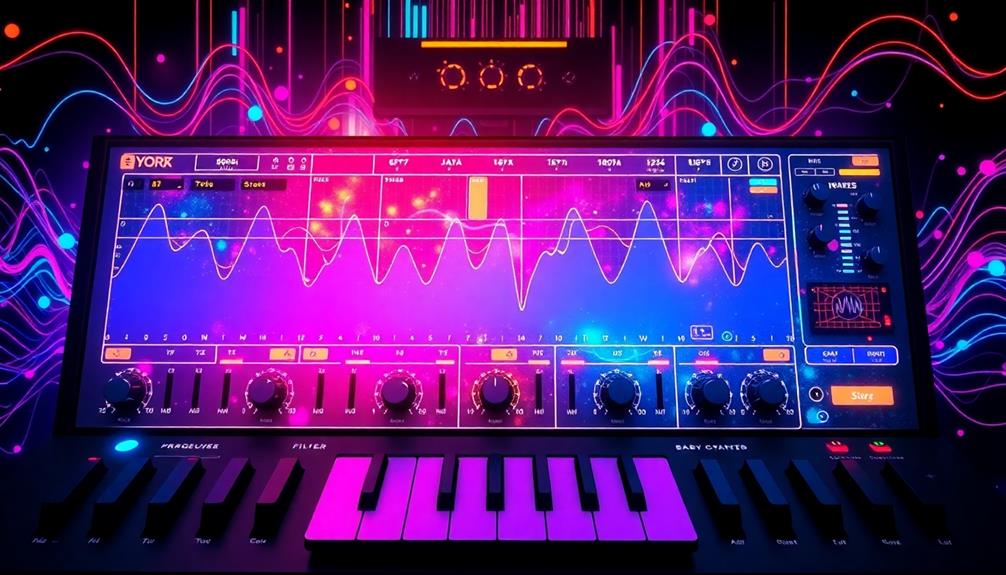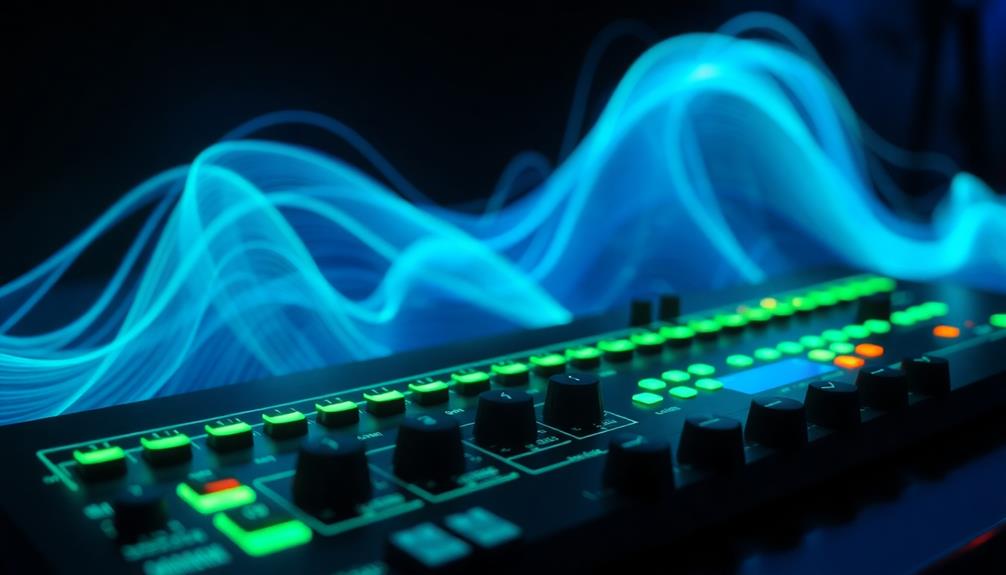To design the perfect bass sound from scratch, start with a sawtooth wave for its rich harmonics. Layer in a square wave to add depth, tuning them carefully for frequency separation. Use low-pass filters to shape your tone and keep the sub-bass (20-40 Hz) distinct from your kick drum. Adjust your attack and decay settings for a dynamic response, and automate filter parameters for expressiveness. Experiment with modulation techniques to create evolving sounds. Remember, clarity is key, and the right layering will enhance your mix. There's much more to uncover about bringing your unique bass sound to life.
Key Takeaways
- Start with a sawtooth wave for rich harmonic content and layer a square wave for added depth and complexity.
- Carefully adjust filter settings to shape the tonal character and emphasize low-end frequencies for a powerful bass sound.
- Utilize frequency separation by ensuring sub-bass and kick drum frequencies do not overlap to maintain clarity and avoid muddiness.
- Experiment with modulation techniques and automation for dynamic changes, enhancing expressiveness in your bass sound.
- Incorporate slight detuning of oscillators and adjust attack/decay settings to create a fuller, richer bass presence in the mix.
Understanding Bass Sound Design

When diving into bass sound design, you'll quickly realize that achieving a powerful, clean bass tone demands a thoughtful approach. To create a rich sound in the 100-200 Hz range, focus on layering and advanced techniques. Stock presets often yield thin or muddy tones, so you'll want to avoid them.
Consider using FM synths, and experiment with high-pass filters set to low cutoff frequencies, typically between 20-50 Hz. This can greatly enhance your bass sound's depth and character.
You should also pay attention to the number of oscillators you use. Fewer oscillators help maintain phase consistency, which is vital for a solid bass foundation. Using waveforms like saw, square, or pulse-width modulation (PWM) can add mid-range richness, layering your bass instruments effectively.
Proper frequency management is essential, too, especially since overlapping sub lows from your bass and kick drum can clutter your mix. Techniques like sidechain compression will help you maintain clarity.
Key Techniques for Synthesis

Synthesis techniques play an essential role in crafting the perfect bass sound. Start with a sawtooth wave as your primary oscillator; its rich harmonic content is ideal for bass sounds. Adding a second oscillator using a square wave can enhance depth and complexity.
Next, utilize a virtual analog filter to shape your sound. Adjust the cutoff frequency to sculpt your tonal character and engage the filter for added warmth. The envelope parameters are vital; set slower attack times for a smoother onset and longer release times for sustain, making your bass sound more dynamic.
Incorporate modulation by assigning the filter cutoff to a modulation source, allowing for a lively movement in your sound. Automate parameters like release time for extra expressiveness, especially in relation to the kick drum, as it'll help achieve a solid groove.
Lastly, experiment with effects like distortion and phaser to add character and texture to your bass. Just remember to monitor your drive levels to prevent clipping and maintain clarity.
Oscillator and Filter Choices

When crafting your bass sound, the choice of oscillator waveforms is essential; a sawtooth can give you that rich foundation, while layering a square wave adds depth.
Don't underestimate the importance of filter settings—adjusting the cutoff frequency can drastically change your tone.
Experiment with modulation techniques to bring your bass to life, ensuring it evolves and maintains interest throughout your track.
Choosing Waveform Types
Choosing the right waveform types is essential for crafting an impactful bass sound. Start with a sawtooth waveform as your primary oscillator; its rich harmonic content provides a bright and full foundation. To enhance complexity, add a square wave as a second oscillator. Slightly detuning it generates a thicker texture, giving your bass more presence in the mix.
Here's a quick reference to help you choose the right waveforms:
| Waveform Type | Characteristics |
|---|---|
| Sawtooth Waveform | Rich harmonics, full-bodied sound |
| Square Wave | Thicker texture when detuned, adds warmth |
| Low-Pass Filter | Removes higher frequencies, emphasizes low-end |
| Virtual Analog | Provides warmth and character |
| Envelope Settings | Adjust release time for sustain and punchiness |
Utilizing a low-pass filter is vital for shaping your bass sound. It removes unwanted higher frequencies, allowing the low-end to dominate. Combine this with well-adjusted envelope settings to create the sustain you want, whether smooth or punchy. This foundation will set you up for a powerful bass sound that stands out in your mix.
Filter Settings Importance
After establishing the right waveforms for your bass sound, it's time to focus on filter settings, which play a pivotal role in shaping your overall tone. Engaging a virtual analog filter is essential because it adds warmth and character. Applying low-pass filtering can effectively reduce higher frequencies, allowing you to emphasize the low end.
When adjusting the filter cutoff frequency, aim for a balance between clarity and depth. Too high, and you lose the richness; too low, and your bass might sound muddy. Experimenting with different filter types—like low-pass, high-pass, and band-pass—can greatly alter your bass's texture and presence in the mix.
Don't overlook the importance of envelope settings. Tweak the decay and release parameters to influence how your bass evolves over time, impacting its sustain and punch.
Additionally, utilizing modulation on the filter cutoff can create dynamic movement, making your bass sound more engaging and expressive. With careful attention to these settings, you'll craft a bass sound that not only fills the space but also captivates your audience.
Oscillator Layering Techniques
Achieving a rich and powerful bass sound hinges on effective oscillator layering techniques. Start by layering different types of oscillators; for instance, combine a sawtooth wave for its rich harmonic content with a square wave for its punchy mid-range. This combination creates a fuller, more complex bass sound that stands out in the mix.
To enhance the texture and richness, slightly detune the oscillators. This prevents your bass from sounding thin or one-dimensional.
Incorporating a second oscillator an octave lower can add depth and weight, making your bass feel even more powerful. Remember to utilize a low-pass filter on your layered oscillators to shape the sound. This helps remove unwanted high frequencies, resulting in a warmer and more focused tone.
Layering Strategies for Depth

When layering bass sounds, frequency separation is key to achieving clarity and depth.
You'll want to use oscillator tuning techniques to guarantee each layer complements the others, creating a rich texture.
Effective layering methods, like adjusting attack and decay settings, can enhance the dynamic quality of your bass, making it stand out in the mix.
Importance of Frequency Separation
Frequency separation is essential for crafting a clear and impactful mix, especially when it comes to bass sounds. When you're layering bass instruments, it's imperative to guarantee that each element occupies its own frequency range. This approach prevents muddiness and keeps your mix clean.
For instance, the sub-bass frequencies (20Hz-40Hz) must be distinctly separated from your kick drum. You can achieve this by cutting the sub frequencies from either the kick or the bass line, giving each sound its own space and presence.
To enrich your bass depth, consider using multiple layers that emphasize different frequency ranges. Some layers can highlight sub lows, while others provide mid-range presence, allowing for a fuller sound.
While detuning oscillators slightly can enhance texture, it's essential to maintain harmonic integrity to avoid a muddy mix.
Additionally, varying attack and decay settings across different bass layers can greatly influence how they interact, enhancing the perceived depth and richness of your overall sound.
Oscillator Tuning Techniques
Exploring oscillator tuning techniques can considerably enhance the depth and complexity of your bass sound. One effective method is layering different oscillators, such as a sawtooth and a square wave. This combination creates a richer texture, boosting both sub and mid-range presence in the mix.
With advancements in mobile gaming technology, you can also consider how these sound design techniques can be applied to enhance user interactions in immersive environments.
Another essential aspect is slightly detuning oscillators by a few cents. This simple adjustment can add depth and fullness, making your bass more dynamic and engaging.
To further refine your sound, adjust the attack and decay settings on your layered oscillators. This variation helps maintain harmonic integrity while avoiding muddiness.
Incorporating pulse width modulation (PWM) on square waves can elevate tonal quality, providing warmth and character without overpowering other elements.
Effective Layering Methods
Building on the oscillator tuning techniques you've mastered, effective layering methods can take your bass sound to the next level. Start by layering multiple oscillators, like a sawtooth and a square wave, to create a fuller, richer bass sound. Make certain each layer complements the others without overpowering them. This balance is essential for achieving a robust sound.
Next, focus on managing the frequency ranges of your layers. For instance, let one layer emphasize sub lows while another highlights mid-range presence. This strategy prevents muddiness and maintains clarity. You can enhance the texture and depth by applying detuning techniques on your layered oscillators, which also helps create a wider stereo image.
Adjusting the attack and decay settings on different layers impacts how they interact, allowing you to shape the overall bass character with variations in punchiness and sustain.
Finally, implement sidechain compression between the kick and bass layers. This technique guarantees clarity in your mix, giving each element its own space and preventing competing frequencies.
Frequency Management in Mixing

Achieving clarity in your mix hinges on effective frequency management, particularly between kick drums and bass lines. To avoid muddiness, make certain the frequency ranges of your kick and bass don't overlap too much. Typically, you'll want to cut the sub lows from the bass that conflict with the kick's frequency range, allowing each element to shine.
Utilizing sidechain compression can be a game-changer here. By reducing the bass volume at the moment of kick hits, you create space for both elements to coexist without masking one another. This technique enhances the overall punchiness of your low end, making it more impactful.
Having dedicated subwoofers is also vital for accurately monitoring those low frequencies, especially since synth bass can hit as low as 15Hz.
When designing your bass sounds, avoid working in isolation; context within the full mix is essential. If you layer sounds, make sure that a subby kick and subby bass don't coexist, as this can lead to a cluttered low end.
Modulation and Automation Techniques

How can you elevate your bass sound to new heights? By incorporating modulation and automation techniques into your sound design, you can create a more dynamic and engaging bass experience.
Assigning filter cutoff as a modulation source allows for real-time changes in tone, giving your bass an evolving character that keeps it interesting throughout your track.
Automation plays a vital role too. By automating the release time, you can achieve expressive changes in sustain, making your bass sound more responsive and engaging in the mix. Automation plays a vital role too. By automating the release time, you can achieve expressive changes in sustain, making your bass sound more responsive and engaging in the mix. Utilizing smart presets to boost workflow allows you to dial in effective starting points quickly, saving time while maintaining creative flexibility. These presets can be further fine-tuned to complement the dynamics of your track, ensuring a polished and professional sound.
Additionally, utilizing the reverb mix button as a modulation source grants you control over the spatial qualities of your bass, enhancing its depth and presence.
Don't forget about effects! Implementing automation for distortion and phaser can add extra texture and unique character, ensuring your bass stands out without overwhelming other elements.
Customizable modulation sources in your synth interface provide the flexibility to experiment with various parameters, allowing you to tailor your sound design to fit your vision perfectly.
With these techniques, you'll take your bass sound beyond the ordinary and into the domain of the extraordinary.
Finalizing Your Unique Sound

With your modulation and automation techniques in place, it's time to refine and finalize your unique bass sound. Focus on these key elements:
- Monitor Drive Level: Verify the drive level of any distortion effect is carefully adjusted to prevent clipping. This keeps your bass sound clear and deep in the mix.
- Incorporate a Phaser Effect: Add a phaser effect to introduce texture and movement. This enhances your bass's presence, making it more engaging in the overall mix.
- Experiment with Effects: Don't hesitate to explore various effects within your synth. This experimentation can lead to creative layering and added complexity in your sound.
As you finalize, utilize those modulation techniques you've set up. Automating the filter cutoff and reverb mix will bring your bass sound to life, adding dynamic changes over time.
Finally, once you're satisfied with your sound, save it with a descriptive name—like "Bass 2"—for easy recall in future projects. This fosters consistency in your music production.
With these steps, you're well on your way to crafting a standout bass sound that's uniquely yours!
Frequently Asked Questions
How Do You Make a Good Bass Sound?
To make a good bass sound, start with a sawtooth wave, add a virtual analog filter for warmth, layer in a square wave for richness, and use modulation and effects to enhance character and texture.
How Do You Make a Bass Sound Like a Synth Bass?
Imagine a deep, throbbing bass that pulses through your chest. You start with a sawtooth wave, layer in a square wave, and sculpt it with filters, envelopes, and effects to shape your unique synth bass sound.
How to Make Bass Hit Harder?
To make your bass hit harder, focus on sub-bass frequencies, use sidechain compression with your kick, layer oscillators for depth, add saturation for warmth, and EQ to clear conflicting frequencies. It'll punch through your mix!
Is Serum Good for Bass?
Absolutely, Serum's renowned for crafting bass sounds. Did you know 70% of top producers trust it for bass design? Its advanced wavetable synthesis and modulation options let you create unique, powerful bass tones that truly stand out.
Conclusion
In crafting your perfect bass sound, think of it as planting a seed in a garden. Nurture it with the right oscillators and filters, allowing your layers to blossom into a rich, full spectrum. As you fine-tune frequencies and sprinkle in modulation, watch your creation thrive. Remember, every tweak is like watering your plant—essential for growth. Embrace the journey, and let your unique sound flourish, turning your sonic landscape into a vibrant, thriving ecosystem.










